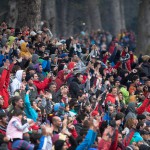The powers behind MXGP (FIM, Youthstream and the manufacturers) are next due to sit around a table after the Motocross of Nations at Ernee in two weeks time. On the agenda could be a number of topics (why the 2016 provisional calendar has stretched to nineteen rounds for example) and perhaps delicate first moves towards changing the capacity of the premier class, as a debrief on 2015 is likely to conclude that speeds are still climbing as are the frequency of visits to Medical Centres.
Maybe it is time to seriously discuss the potential of morphing Grand Prix into a one-day spectacle for the MXGP and MX2 categories, particularly in the current guise with so many European support races as part of the programme. The advantages would include valuable time for track maintenance (the Pros constantly gripe that the 125, 150, 250, 300 riders leave different types of bumps and ruts) and the creation of real Grand Prix ‘show’ on the Sunday while the European Championships could provide a full race timetable for fans on Saturday. If the public want solely to glimpse Cairoli, Febvre, Paulin, Herlings and co then there is a fantastic opportunity on Saturday for autograph signings, Q+A sessions in the paddock and corporate responsibilities that sponsors can therefore milk (and thus increase marketing worth and brand building potential of Grand Prix). MXGP stars will still be at circuits for the full weekend but the balance of the entertainment shifts and – like a boxing match card – there is a real hype to the main event.
A well-received consequence (having listened to riders talking about the subject) would mean that the Saturday Qualification Heat disappears. Where is the advantage in this? Well, take eighteen Grands Prix with two motos and add another eighteen Qualification starts and that means riders are bolting out of the gate fifty-four times in a season. Removing the Heat sprint would immediately reduce risk of crashes and carnage by a third. A short practice and ‘Super Pole’ format on Sunday morning would satisfy riders and amplify interest for spectators.
While we’re at it let’s also hack at the overall format. How about a first moto that carries a smaller scale for championship points (for top ten) and the classification decided the order in the gate for a potentially longer second moto? That race would be the decider for the Grand Prix victory and podium, the one that gets televised live and is the real focal and highpoint of the event and weekend.
What do we have in opposition to this scheme? Firstly there is tradition and Youthstream’s stated reluctance to condense Grand Prix and potentially affect a circuit’s chances of drawing in a crowd over two days. This thinking is weakened slightly by EMX that seems to be growing in dates, participants and prestige every year. The European races are very unlikely to leave Grand Prix fixtures now so why not make a clear definition? Secondly there is the matter of broadcasting and Youthstream’s wish to have at least the second motos of the EMX classes televised and shown on their comprehensive MXGP.tv channel and copious YouTube channel of content. Currently only races on Sunday are run under the gaze of the cameras and to cover both days means a budget hike.
Whatever is said and planned at Ernee it does feel like MXGP is heading for a shake-up. For several years the two-motos-per-class, four-on-the-day scheduling means that Grand Prix is barely appropriate for realistic terrestrial TV coverage. It is too long, drawn-out and convoluted. There is also pressure to move the sport in a direction where it is deemed to be safer. Rather than trying to clear high, difficult and polemic hurdles such as capacity alterations with the manufacturers, try removing Heat races and paying extra attention to track care.
I’d love to see some sort of survey or opinion poll carried out in the paddock for these types of changes. I believe there would be a lofty degree of favouritism and together with interesting ideas like a stadium-based motocross Grand Prix – that I sadly hear has been put on ice – it would give people cause to feel vibrant and excited about where the sport might go in the next ten years.
Photo by Ray Archer








